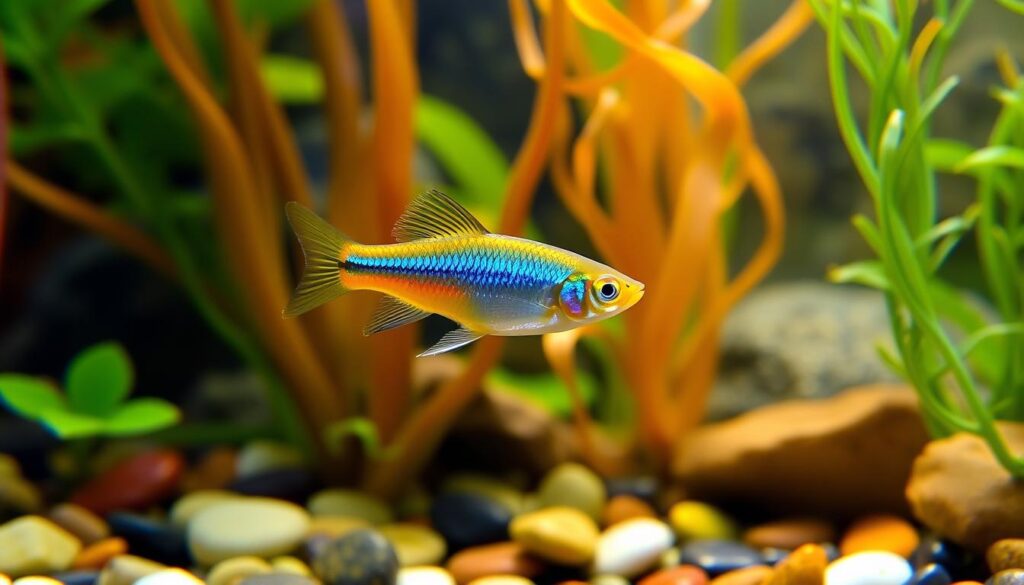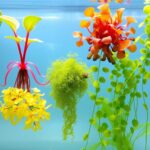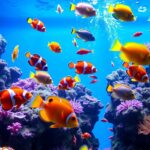Did you know the Ember Tetra can live over a decade in captivity? This fact shows they are a long-term commitment for aquarium fans. As a tropical fish lover, I’m excited to share more about these fascinating fish.
Ember Tetras, scientifically known as Hyphessobrycon amandae, belong to the Characidae family. They are small, reaching only 2-3 cm (0.8-1.2 inches) in length. This makes them perfect for small tanks. Their bright red-orange color adds a splash of color to any aquarium.
These fish come from Brazil and love planted tanks with dark bottoms. They are peaceful and hardy, making them great for community tanks. Plus, they are easy to care for, making them perfect for both new and experienced fishkeepers.
In the wild, Ember Tetras eat small invertebrates and plants. In our tanks, they eat a variety of foods, from flakes to frozen treats. Eating different foods helps keep their colors bright.
Key Takeaways
- Ember Tetras can live over 10 years in well-maintained aquariums
- They grow to a maximum length of 2-3 cm (0.8-1.2 inches)
- Native to Brazil, they prefer planted tanks with dark substrates
- Ember Tetras thrive in groups of at least 6, preferably 9-10
- They accept a variety of foods, including flakes, frozen, and live options
Introduction to the Ember Tetra
I’m thrilled to talk about the Ember Tetra, a captivating fish from South America. These small fish have won the hearts of many aquarium lovers. They are part of the characins family and bring beauty and personality to any tank.
Origin and Natural Habitat
Ember Tetras come from the rich waters of Brazil, in the Araguaia River basin. As characins from South America, they love soft, slightly acidic waters with lots of plants. Their home in nature helps us understand how to care for them in tanks.
Physical Characteristics
These tiny fish are truly a wonder to see. They grow up to 2 centimeters (0.8 inches) long but make a big impact with their bright red-orange color. Their transparent body and a hint of copper make them seem to glow.
Popularity in the Aquarium Hobby
Ember Tetras are a big hit in the aquarium world. Their bright colors, lively nature, and calm behavior are perfect for both new and experienced fish keepers. In planted tanks, a group of 20-25 Ember Tetras looks amazing, like a school of living flames.
| Characteristic | Detail |
|---|---|
| Maximum Size | 2 cm (0.8 inches) |
| Lifespan | 2-4 years |
| Ideal Group Size | 10 or more |
| Preferred Temperature | 72-82°F (22-28°C) |
| pH Range | 5.0-7.0 |
Setting Up the Perfect Ember Tetra Aquarium
I love making the perfect home for my freshwater fish, especially ember tetras. These small fish need certain conditions to do well. I’m excited to share how to set up their ideal space.
Tank Size Requirements
A 10-gallon tank is the minimum for a small group of ember tetras. They like being in groups of 6-10 fish. For a bigger school, go for a 20-gallon long tank. This size gives them more room to swim and keeps the water stable.
Water Parameters and Conditions
Ember tetras need certain water conditions to thrive. I keep the temperature at 72-84°F (22-28°C) and the pH at 5.5-7.5. They like soft to moderately hard water. To mimic their natural home, I use dark substrate and add plants, driftwood, and catappa leaves.
Filtration and Maintenance
For these delicate fish, gentle filtration is important. I use a sponge filter or a standard filter with a sponge to reduce the flow. Keeping the water clean is key – I change 20-25% of the water weekly.
| Parameter | Ideal Range |
|---|---|
| Temperature | 72-84°F (22-28°C) |
| pH | 5.5-7.5 |
| Tank Size | 10+ gallons |
| Group Size | 6-10 minimum |
By following these tips, I’ve made a great home for my ember tetras. They show off their bright colors and natural behaviors in my aquarium.
Ember Tetra Care Guide
Caring for ember tetras is rewarding for any freshwater fish lover. These small tropical fish grow to only 0.8 inches long. They’re perfect for small tanks. I keep mine in groups of at least 6 in a 10-gallon tank. A 20-gallon tank with 20-25 fish shows off their beauty.
Keeping the water right is key for ember tetras. I keep the temperature between 72°F to 84°F. The pH level should be 5.5 to 7.0. Regular water tests and changes are a must for these sensitive fish.
Feeding ember tetras is fun. Because they’re small, I feed them several times a day. Their diet includes:
- High-quality flake food
- Micro pellets
- Frozen or live foods like brine shrimp
With the right care, ember tetras can live up to 4 years. I add lots of plants and hiding spots to reduce stress and show off their colors. These fish are peaceful and fit well in many aquariums.
Dietary Needs of Ember Tetras
Feeding ember tetras is a fun task for aquarium fish lovers. These small fish, only 0.8 inches long, need a special diet to stay healthy and colorful.
Recommended Foods
Ember tetras eat both plants and small animals. They do well on a diet that includes:
- Nano pellets
- Crushed flakes
- Baby brine shrimp
- Daphnia
- Cyclops
- Rotifers
Feeding Frequency and Amount
Ember tetras like to eat small meals often during the day. They can’t eat a lot because they are so small. I feed them 2-3 times a day, giving them just enough to eat in about 2 minutes each time.
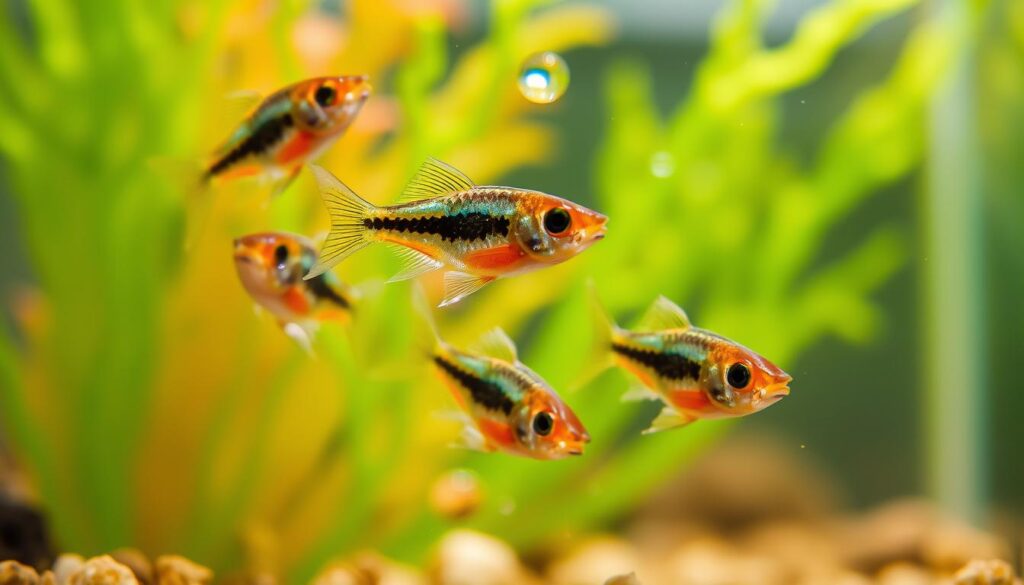
Importance of a Varied Diet
It’s important to feed ember tetras a variety of foods. This keeps them healthy and bright orange-red. I switch up the food types to make their diet more like what they would eat in the wild. This not only keeps them healthy but also makes them more lively and fun to watch.
| Food Type | Frequency | Benefits |
|---|---|---|
| Dry Foods | Daily | Essential nutrients |
| Live Foods | 2-3 times weekly | Natural behavior stimulation |
| Frozen Foods | 1-2 times weekly | Variety and nutrition boost |
Ember Tetra Behavior and Social Dynamics
Ember tetras are fascinating fish with unique social behaviors. They love living in groups, making them great for community aquariums. It’s important to keep at least six ember tetras together for their health and natural behavior.
These fish are active swimmers, staying in the middle layer of the tank. They are great at making shy fish feel safe. They don’t form tight schools but rather loose shoals, adding life to the tank.
“Watching ember tetras interact in a group is like observing a delicate dance in the water. Their vibrant colors and fluid movements are truly captivating.”
Here’s a breakdown of ember tetra social dynamics:
| Behavior | Description |
|---|---|
| Group Size | Minimum of 6, preferably more |
| Swimming Pattern | Loose shoaling |
| Tank Level | Middle layer |
| Temperament | Peaceful and social |
| Interaction with Others | Excellent dither fish |
Watching these small fish has taught me a lot about the aquatic world. Their behavior not only makes the aquarium lively but also shows us the social lives of tropical fish.
Compatibility with Other Fish Species
Ember tetras are great for community fish tanks. They are loved by tropical fish fans. These small fish do well with peaceful species. It’s important to make a tank that is peaceful for them.
Ideal Tank Mates
Choosing the right friends for ember tetras is key. Look for small, peaceful fish. Here are some good choices:
- Cardinal tetras
- Rasboras
- Corydoras catfish
- Guppies
- Otto catfish
These fish like the same water and act similarly. Ember tetras also get along with cherry shrimp, but watch out for the tetras eating the baby shrimp.
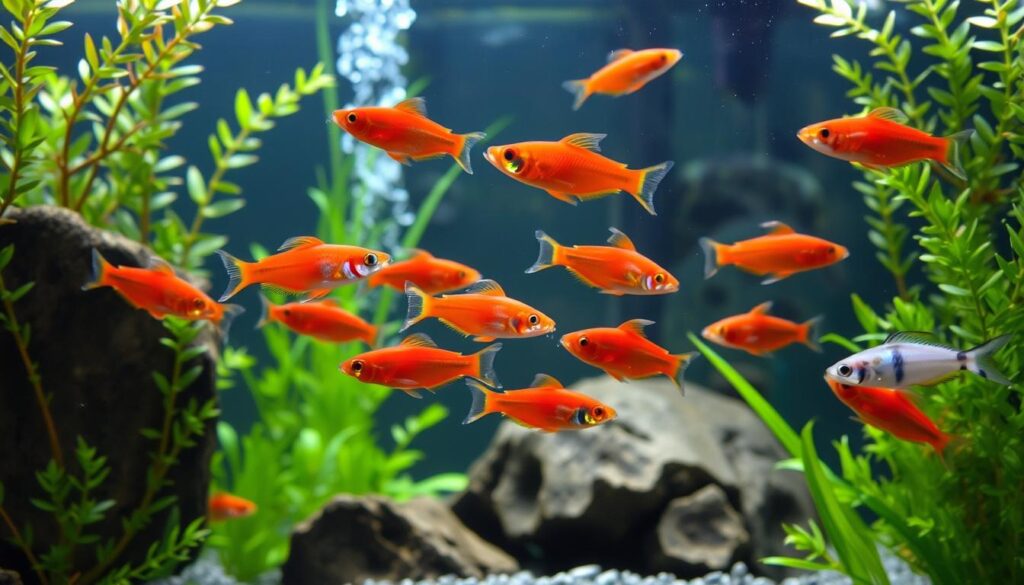
Species to Avoid
Ember tetras can be tricky with some fish. Stay away from:
- Large, aggressive fish
- Fast-moving species that might stress the tetras
- Fin-nipping fish
Always check out the fish you plan to add to your tank. Some fish, like emperor tetras, can grow big and might scare the ember tetras.
| Compatible Species | Adult Size (inches) | Minimum Tank Size (gallons) |
|---|---|---|
| Ember Tetra | 1 | 10 |
| Cardinal Tetra | 2 | 20 |
| Corydoras | 1-3 | 20 |
| Guppy | 1-2 | 10 |
| Otto Catfish | 1-2 | 10 |
Planning your tank well can make a beautiful, lively aquarium. It’s fun to watch.
Breeding Ember Tetras in Captivity
Breeding fish can be very rewarding, especially with tropical fish like the ember tetra. As a freshwater fish enthusiast, I’ve learned that breeding these colorful fish takes some prep and patience.
Breeding Tank Setup
To begin, I set up a separate breeding tank that’s at least 10 gallons. The water needs to be soft and a bit acidic, with a pH of 5.5 to 7.5. I keep the temperature between 72°F and 82°F, ideal for these tropical fish. Dense plants like java moss offer shelter and places for spawning.
Spawning Process
Ember tetras are egg scatterers. To boost breeding success, I keep at least six fish together, ensuring a mix of males and females. Males are slender, while females have fuller bodies. During spawning, the female lays eggs among plants, and the male fertilizes them.
Caring for Fry
After spawning, I move the adults to another tank to stop them from eating the eggs. The fry hatch in 24-36 hours. At first, I feed them infusoria and powdered fry food. As they get bigger, I add baby brine shrimp to their diet. Keeping the water super clean is key for the fry’s survival. With the right care, these little fish grow to about 0.8 inches in a few months.
Breeding ember tetras has made me appreciate these fascinating fish even more. It’s a journey that needs careful attention but shows a unique view into the life cycle of these beautiful tropical fish.
Health and Common Issues in Ember Tetras
As an aquarium fish enthusiast, I’ve learned that taking good care of ember tetras is key. These tropical fish are usually tough, but they can get sick if not cared for right. Keeping their water clean and their environment stress-free is the secret to their health.
Ich, a parasitic infection showing as white spots, is a common problem I’ve seen. To avoid this and other diseases, I always keep new fish in quarantine before adding them to my main tank. This has really cut down on the spread of sickness in my fish tank.
Fin rot is another issue ember tetras face, often from bad water or injury. I’ve found that good filtration and regular water changes help prevent this. Also, giving them a varied diet boosts their immune system.
“A healthy ember tetra is active, vibrant, and displays its characteristic orange-red coloration.”
Here’s a quick guide I use to check on ember tetra health:
| Symptom | Possible Cause | Action |
|---|---|---|
| White spots on body | Ich | Raise temperature, treat with medication |
| Frayed fins | Fin rot | Improve water quality, use antibiotic treatment |
| Loss of color | Stress or poor nutrition | Check water parameters, improve diet |
| Rapid breathing | Low oxygen levels | Increase aeration, check filter |
By being watchful and acting fast on any problems, I’ve kept my ember tetras healthy and colorful. Remember, it’s always better to prevent issues than to cure them in fish care!
Conclusion
I’ve learned to love the ember tetra as a standout freshwater fish. These small, colorful fish add life and beauty to any tank. They fit well in small spaces, needing at least 10 gallons to be happy.
Looking after ember tetras is easy. They like water that’s 70-82°F and has a pH of 6.5-7.2. These fish can live up to 6 years in a tank, sometimes even 10 years. They get along well with other peaceful fish like bumblebee otocinclus and red cherry shrimp.
Breeding ember tetras is rewarding for fish keepers. They lay eggs and prefer tanks with lots of hiding spots. Raising their young is a bit tough but very interesting. These fish are perfect for both new and experienced fish keepers, offering a unique and beautiful experience.
FAQ
What are the ideal tank size requirements for ember tetras?
What water parameters do ember tetras prefer?
What should I feed my ember tetras?
How many ember tetras should I keep together?
What are the ideal tank mates for ember tetras?
How do I breed ember tetras?
What are some common health issues in ember tetras?
Source Links
- Ember tetra
- Hyphessobrycon amandae – Ember Tetra — Seriously Fish
- Care Guide for Ember Tetras | Shrimpy Business
- Ember Tetra: Ideal Schooling Fish
- Care Guide for Ember Tetras — Orange Jewels of the Nano Aquarium
- Care Guide for Ember Tetras | Shrimpy Business
- Would Ember tetras be fine in my setup?
- Care Guide for Ember Tetras | Shrimpy Business
- Care Guide for Ember Tetras — Orange Jewels of the Nano Aquarium
- Learn All About the Ember Tetra
- Care Guide for Ember Tetras — Orange Jewels of the Nano Aquarium
- Care Guide for Ember Tetras | Shrimpy Business
- Ember Tetra – Hyphessobrycon amandae Fish Profile & Care Guide
- Ember Tetra: A Fiery Gem for Your Freshwater Aquarium
- Suggestions for fish to complement Ember Tetras?
- Vibrant Aquatic Community: Ember Tetra Tank Mates🐟 | Fish Lab
- Care Guide for Ember Tetras | Shrimpy Business
- Care Guide for Ember Tetras — Orange Jewels of the Nano Aquarium
- Care Guide for Ember Tetras | Shrimpy Business
- Care Guide for Ember Tetras — Orange Jewels of the Nano Aquarium
- Ember Tetras not doing well
- Ember Tetra: Care, Size, Where to Purchase & More
- Ember Tetra – A Bright Peaceful Nano Fish
